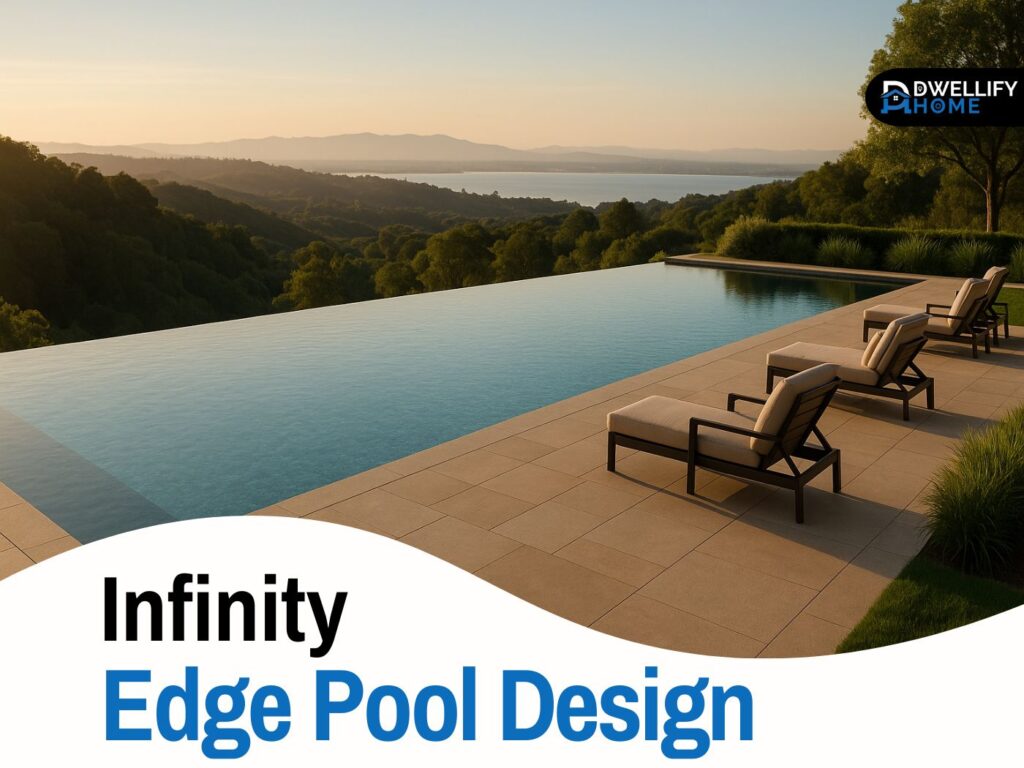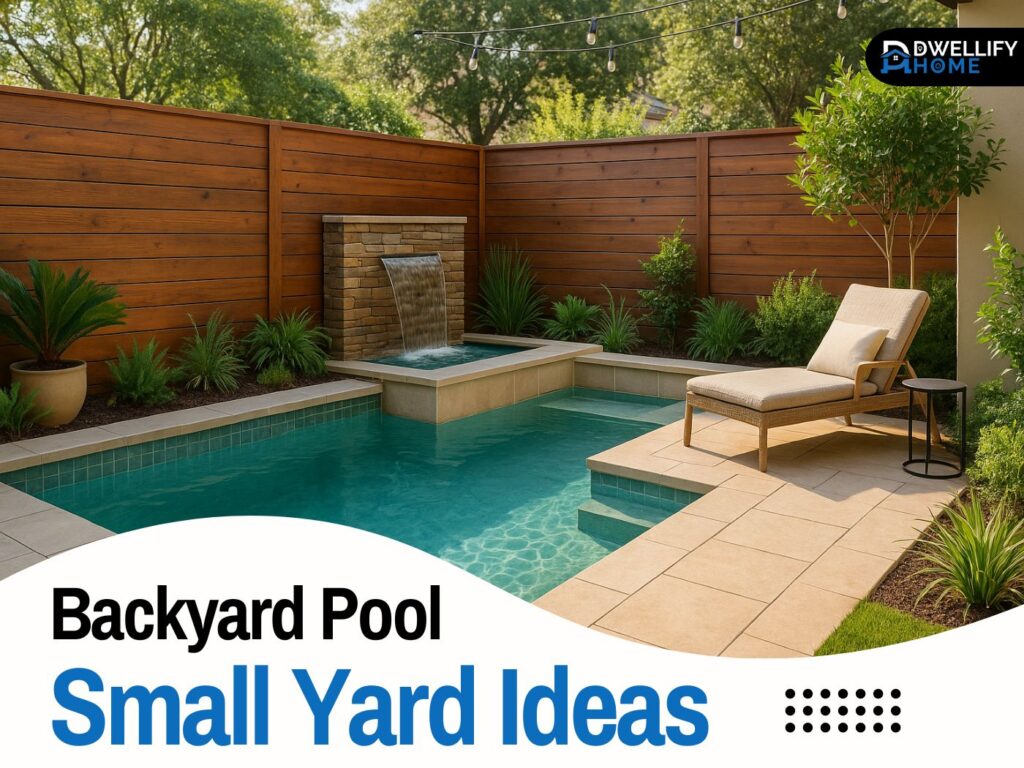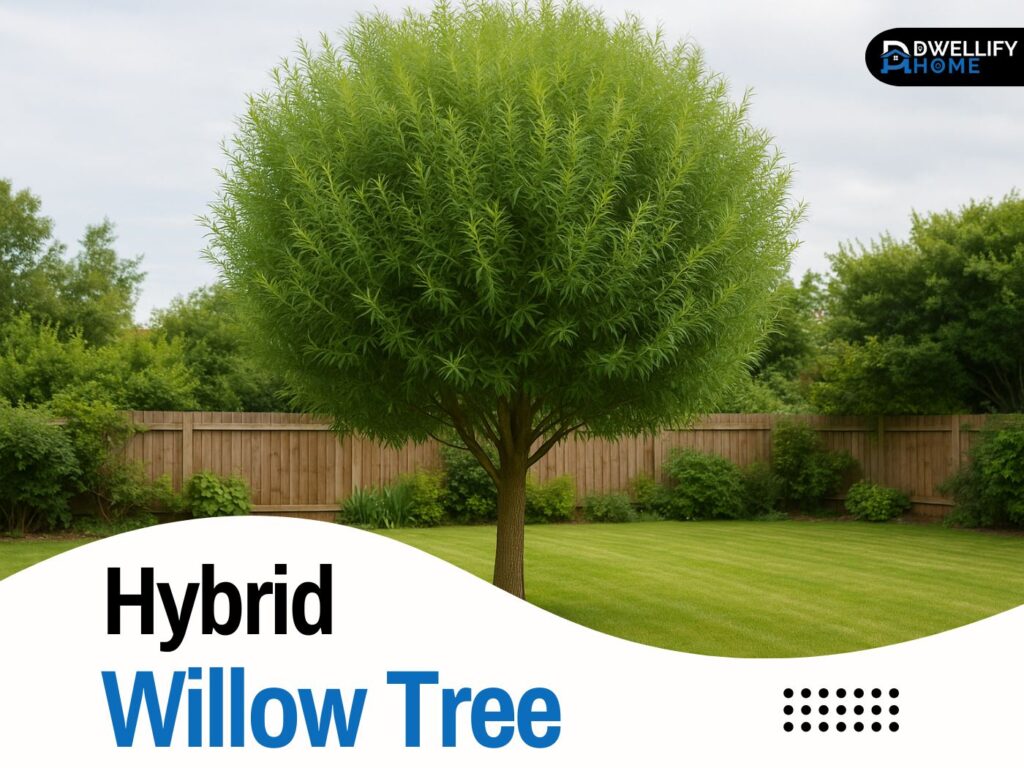There’s something truly magical about watching water flow endlessly into the horizon. That’s the charm of an infinity edge pool. It gives you that breathtaking illusion of water spilling into the sky or ocean. Over the years, I’ve designed dozens of these luxury pools, and trust me, every time the final moment arrives—when the client sees it for the first time—it’s unforgettable.
In this guide, I’ll walk you through everything you need to know about infinity edge pool design: how it works, how it’s built, what it costs, and the details that make it so mesmerizing. Think of it as a friendly chat about turning your backyard into a piece of modern art.
Snippet-Ready Definition:
An infinity edge pool design creates the illusion of water flowing endlessly into the horizon. It uses a hidden catch basin below the edge to recycle water for a seamless visual effect.
Mission Statement
At Dwellify Home, our mission is to inspire homeowners to create elegant, functional, and sustainable living spaces. We believe great design blends beauty with purpose, and through guides like this one on infinity edge pool design, we aim to help you turn architectural dreams into stunning, livable art.
What Is an Infinity Edge Pool
Here’s the thing—an infinity edge pool isn’t about excess. It’s about illusion. It’s designed so that one or more edges appear to vanish into the surrounding view, whether that’s an ocean, valley, or skyline. The water flows over a carefully designed edge, drops into a hidden basin below, and then gets recirculated back into the main pool.
The concept originated decades ago, often used in luxury resorts built on hilltops or near water. But thanks to new technology and creative construction, these designs have now found their way into modern homes. Some people call them vanishing edge, zero edge, or negative edge pools—all terms describing that same elegant visual effect.
A lot of homeowners ask me, “What’s the difference between a vanishing edge pool and an infinity pool?” Honestly, not much. The engineering might vary slightly, but the goal remains the same: to make your pool and your view blend into one stunning picture.
Design Principles Behind the Magic
Creating an infinity edge pool isn’t about pouring concrete and hoping for the best. It’s precision engineering. A small misalignment, even by a few millimeters, can ruin the entire visual flow.
One of the most critical elements is the weir wall—the edge that water flows over. It must be perfectly level. The water should sheet smoothly across the edge, not splash or dribble. Beneath that weir wall sits a catch basin (or balance tank), which collects the overflowing water before pumping it back into the main pool.
During construction, we carefully calculate the catch basin’s capacity, making sure it can handle the flow even when swimmers enter and displace water. Pumps and filtration systems are installed to maintain that continuous, mirror-like effect.
I often tell clients, “Think of it as a loop of serenity.” Every drop of water moves, returns, and renews—just like nature.
Different Types and Styles of Infinity Edge Pools
Not all infinity pools are the same. The design depends heavily on your landscape and vision. Let’s look at a few variations I’ve built over the years.
- Single-edge infinity pools
The most popular design. Usually, one side faces the view—perfect for a sloping backyard or a house overlooking a valley. - Multi-edge pools
Here, two or more sides spill over, creating a 360-degree “floating water” effect. These are often used in high-end estates or resorts. - Perimeter overflow or zero-edge pools
These are designed so the water is perfectly level with the surrounding deck. The result? A sleek, ultra-modern look that’s perfect for contemporary architecture. - Small infinity pool designs
Compact spaces can still enjoy luxury. A rooftop or courtyard infinity pool can use glass panels for a modern twist. - DIY or modular infinity pools
I’ve seen a few homeowners try simplified versions using prefabricated modules. While possible, I’d always recommend consulting a pool engineer—precision is everything here.
Each design has its own personality. For example, I once built a hillside infinity pool in Arizona that reflected the red desert sky at sunset—it was like painting with water.
Site Planning: Making It Work With Your Landscape
Guess what? The site makes or breaks an infinity edge pool. You need elevation, visual alignment, and stability. The illusion only works if the edge points toward a clear horizon—like an ocean, valley, or mountain line.
A sloped site is perfect. The steeper the drop, the more dramatic the illusion. But with that comes structural challenges—retaining walls, soil reinforcement, and drainage systems. Flat sites can work too, but they require more engineering and cost.
Lighting also matters. Positioning your pool where the sunlight hits the edge creates a soft shimmer, enhancing that “endless water” feel. I’ve learned to orient edges toward sunset views whenever possible. Clients love how the light glows across the water at dusk.
And yes, safety matters. Local building codes often require fencing or edge protection, especially in family homes. So, design beauty always goes hand-in-hand with compliance.
How Infinity Edge Pools Are Built
Building an infinity pool is a precise, multi-stage process. Here’s how it typically unfolds:
- Site excavation and grading – The foundation must support both the pool and the catch basin below.
- Formwork and steel reinforcement – Concrete shells are reinforced with steel to prevent cracks.
- Waterproofing – Special membranes or coatings ensure zero leaks.
- Weir wall and overflow setup – This is the magic line. The edge must be leveled to perfection.
- Plumbing and hydraulics – Pumps and pipes are installed for smooth water circulation.
- Finishing – Tiles, decking, and lighting come next, bringing texture and elegance.
- Testing and tuning – Before filling it completely, we run flow tests to make sure water spills evenly.
A client once told me watching the first flow of water across the edge was “like seeing a painting come alive.” That’s exactly how it feels.
Infinity Edge Pool Design Cost
Let’s talk numbers, because this part often surprises people.
The cost depends on several factors:
- Site slope and access
- Pool size and design complexity
- Material selection (tile, stone, glass, concrete)
- Engineering and safety systems
A basic simple infinity edge pool design might start around $60,000–$80,000, while high-end multi-edge or hillside builds can cross $150,000 or more. The catch basin, extra pumps, and structural work are what push the price higher.
But here’s the best part—you can optimize cost smartly:
- Use local stone or porcelain tile instead of imported marble.
- Keep the design single-edged instead of double-edged.
- Incorporate efficient pumps and automated refill systems to save long-term energy costs.
Remember, infinity pools aren’t just about luxury; they’re long-term investments that enhance your property’s value and appeal.
Maintenance and Longevity
Now, let’s be honest—an infinity edge pool does need care. The good news is, with modern automation, maintenance isn’t as tough as it used to be.
Regular cleaning of the catch basin is crucial since it collects debris that flows over the edge. Auto-leveling sensors can handle water balance automatically, so you won’t have to refill manually every day.
As for the pumps and filters, I recommend an annual professional checkup to keep water flow smooth. It’s also smart to use non-slip materials on the weir wall for safety.
Here’s a tip from experience: set up an automation system that monitors water levels, pH, and temperature. It’ll keep your pool pristine and efficient while saving you time.
Pros, Cons, and Safety Factors
Let’s weigh it all out.
Pros
- Creates a resort-style look that’s visually unmatched
- Boosts property value significantly
- Offers a relaxing, continuous sound of flowing water
- Better circulation compared to standard pools
Cons
- Higher installation cost
- More complex plumbing and construction
- Requires a suitable slope or strong structural base
Safety Concerns
Are infinity pools dangerous? Not really—if built correctly. The water doesn’t drop off into the abyss. There’s always a hidden basin right below the edge. For added safety, we use non-slip edges, maintain clear water depth, and follow code requirements.
So no, you’re not swimming off the cliff—you’re just enjoying an illusion built with precision and beauty.
Inspiration and Design Ideas
Here’s where creativity shines. Every infinity edge pool can tell a story.
Imagine a glass-walled infinity pool on a rooftop, where the city lights reflect below you. Or a stone-edged pool overlooking a mountain valley. I once designed a pool that blended with the ocean view so seamlessly, guests couldn’t tell where the pool ended and the sea began.
You can also explore small infinity pool designs for tight spaces—think compact decks, plunge pools, or even L-shaped layouts. Adding LED lights, waterfalls, or fire features turns your backyard into a nighttime oasis.
If you’re into modern design, go for a zero edge pool design where water level matches your deck height—it looks sleek and futuristic.
Planning and Hiring the Right Experts
This step is crucial. Infinity edge pools require coordination between designers, engineers, and contractors. When hiring, look for:
- Proven experience with hillside or vanishing edge projects
- Licensed structural engineers
- Transparent cost estimates
- Portfolio with at least three completed infinity pools
Ask for detailed infinity edge pool design plans before construction starts. These should include hydraulic layouts, basin dimensions, and edge specifications.
Permits are also essential. Depending on your city, you may need approvals for structural loads and water use. Don’t skip them—compliance ensures safety and longevity.
Eco-Friendly and Future Trends
The world’s moving toward sustainable luxury. Infinity pools are no exception.
You can now design an energy-efficient infinity pool using variable-speed pumps, solar-powered heating, and smart water recirculation systems. Many new builds use eco-friendly materials like recycled glass tiles or low-impact concrete.
And the future? Expect smart automation—pools that clean themselves, adjust pH automatically, and even sync with your phone for water temperature control. Some of my recent clients enjoy remote monitoring right from their living room.
Before and After Transformations
Nothing beats the transformation story. I once converted a regular pool in California into a vanishing-edge masterpiece. We removed one wall, reshaped the basin, and rebuilt the hydraulics. When the owner saw her reflection blending into the Pacific sunset, she said it felt like she was swimming inside the view.
That’s the power of design—it changes how you experience your space.
Comparison Table: Infinity Edge Pool vs Traditional Pool
| Feature | Infinity Edge Pool | Traditional Pool |
| Design Style | Seamless, vanishing edge blending with the view | Defined walls with visible borders |
| Visual Effect | Water appears to flow into the horizon | Contained water surface |
| Structure | Includes catch basin and weir wall | Simple rectangular or freeform shell |
| Ideal Location | Sloped or elevated sites | Any flat backyard |
| Cost Range | Higher due to engineering & materials | Lower overall cost |
| Maintenance | Requires regular edge and basin care | Easier to maintain |
| Aesthetic Appeal | Modern, luxurious, resort-style | Standard residential look |
Step-by-Step Guide: How to Build an Infinity Edge Pool
- Site Evaluation – Analyze slope, soil, and elevation for structural support.
- Design Planning – Create hydraulic and structural drawings with professional input.
- Excavation & Grading – Prepare ground for both pool shell and catch basin.
- Formwork & Reinforcement – Install steel framing for stability.
- Edge Construction – Build the weir wall with millimeter precision.
- Plumbing & Filtration – Connect overflow system, pumps, and balance tank.
- Waterproofing – Apply protective coatings to prevent leaks.
- Finishing Touches – Add tile, decking, lighting, and landscape integration.
- Testing & Adjustment – Run flow tests to ensure perfect water sheeting.
FAQs About Infinity Edge Pool Design
What makes an infinity pool different from a regular one?
Infinity pools use a vanishing edge and a catch basin to create the illusion of endless water flow.
Can I build an infinity pool at home?
Yes, if your site supports it. Sloped terrains work best, but flat areas can be engineered too.
Do infinity pools waste water?
Not really. The water continuously circulates through the catch basin and back into the pool.
How much maintenance does it need?
Routine cleaning, plus yearly equipment checks, keeps it perfect.
Are infinity pools safe for kids?
Absolutely, with proper supervision and non-slip edges.
Conclusion
An infinity edge pool isn’t just a water feature—it’s an experience. It blurs the line between design and nature, between luxury and calm. Whether you’re building one on a hillside overlooking the sea or a small modern backyard version, the key is thoughtful design and expert execution.
If you ever find yourself standing at the edge of one, watching water flow endlessly into the horizon—you’ll understand why I fell in love with this craft. Infinity edge pool design isn’t about showing off. It’s about balance, peace, and the feeling that the world extends right from your backyard.
Disclaimer
This article is for informational purposes only and should not replace professional design or engineering advice. Infinity edge pools involve complex structural, hydraulic, and safety considerations. Always consult licensed contractors and follow local building codes before construction.

I’m Bilal, the founder of Dwellify Home. With 6 years of practical experience in home remodeling, interior design, and décor consulting, I help people transform their spaces with simple, effective, and affordable ideas. I specialize in offering real-world tips, step-by-step guides, and product recommendations that make home improvement easier and more enjoyable. My mission is to empower homeowners and renters to create functional, beautiful spaces—one thoughtful update at a time.




